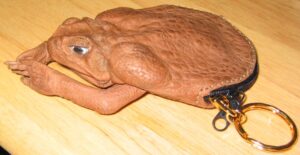 The older I get, the less stuff I want. Whether it’s Christmas, my birthday or Mother’s Day, I’d way rather have phone calls or funny cards or—best of all—in-person visits with my kids and grandkids than presents to unwrap. At least that’s what I used to say until I found out that gifts made from cane toads are a thing.
The older I get, the less stuff I want. Whether it’s Christmas, my birthday or Mother’s Day, I’d way rather have phone calls or funny cards or—best of all—in-person visits with my kids and grandkids than presents to unwrap. At least that’s what I used to say until I found out that gifts made from cane toads are a thing.
What, you might ask, is a cane toad? These nightmarish creatures weren’t even a blip on my radar until I travelled last winter to Florida, where I went to a talk entitled “Alligators and the Ecosystem.” During the presentation, the speaker mentioned the environmental havoc wrought by cane toads in Florida and elsewhere. That’s how I came to learn about the large—and by large, I mean six to nine inches in length and weighing up to three pounds–poisonous amphibians that are considered one of the worst invasive species in the world.
Native to the Amazon basin in South America and extending north to the lower Rio Grande in southern Texas, the toads were introduced elsewhere—including Australia (now home to two billion of them), Guam, Hawaii, Puerto Rico and Florida—in the 1930s in hopes of controlling the sugar cane beetle. Thus their name. Some cane toads were also “accidentally” released by pet stores, animal importers and research laboratories during that era.
Though cane toads didn’t make a dent in the beetle population, their own numbers grew rapidly and they soon encroached on habitat populated by native wildlife. Cane toads breed year-round, with females laying an average of 30,000 eggs twice a year. They’ll eat almost anything, from plants to insects to birds to small mammals to reptiles and other amphibians to pet food to table scraps. Enlarged glands behind the toads’ eyes secrete a milky-white toxin that helps defend them against predators. This poison, present in all life stages from eggs to tadpoles to toadlets to adults, will injure or kill any animal that attacks and is also dangerous, though rarely fatal, to humans.
It’s legal in Florida to hunt and kill cane toads year-round, but it’s not easy. Or pretty. Once stunned with chemicals or a large hammer, the toads can be placed in freezers until they die. They can also be decapitated, with a sharp axe being the tool of choice. After they’re dead, the toads must be disposed of in leak-proof trash receptacles. Because they’re so toxic, burial is not recommended.
Alrighty then.
Not all cane toad carcasses are trashed, however. Some are skinned and the leather cured and made into gifts. No joke. Apparently, the public first became widely aware of cane toads when the then-Premier of Queensland gave a book bound in toadskin leather to Prince Charles and Lady Diana as a wedding gift in 1981. By all accounts, the royal couple was delighted.
These days, thanks to the wonders of international trade, cane toad gifts are readily available. And I’m not just talking t-shirts and ball caps and tote bags and coffee mugs with the likeness of cane toads printed on them. I’m talking the real deal. You can buy belts and boots and bowties made from cane toad leather. You can buy statues in various yoga poses made from real cane toads. You can buy purses and key rings and pouches to hold your guitar picks, most of these items with the head attached and the eyes staring back at you. Many items can be ordered either with or without legs.
I’m not making any of this up. Cross my heart.
But I was kidding when I said I hope my kids and grandkids will give me a cane toad present for Mother’s Day. Because by the time this column hits the newsstand, it will be too late for them to place an order. I guess I’ll have to wait till Christmas.
(May 13, 2023)